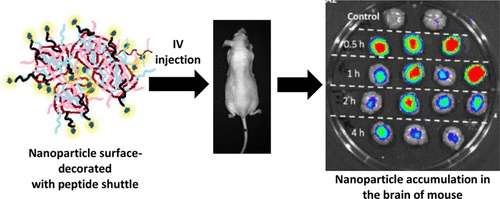当前位置:
X-MOL 学术
›
Chem. Mater.
›
论文详情
Our official English website, www.x-mol.net, welcomes your
feedback! (Note: you will need to create a separate account there.)
Amphiphilic Polymeric Nanoparticles Modified with a Retro-Enantio Peptide Shuttle Target the Brain of Mice
Chemistry of Materials ( IF 7.2 ) Pub Date : 2020-08-24 , DOI: 10.1021/acs.chemmater.0c01696 Alexandra Bukchin 1 , Macarena Sanchez-Navarro 2 , Adam Carrera 2 , Meritxell Teixidó 2 , Angel M. Carcaboso 3, 4 , Ernest Giralt 2, 5 , Alejandro Sosnik 1
Chemistry of Materials ( IF 7.2 ) Pub Date : 2020-08-24 , DOI: 10.1021/acs.chemmater.0c01696 Alexandra Bukchin 1 , Macarena Sanchez-Navarro 2 , Adam Carrera 2 , Meritxell Teixidó 2 , Angel M. Carcaboso 3, 4 , Ernest Giralt 2, 5 , Alejandro Sosnik 1
Affiliation

|
The blood–brain barrier (BBB) is a challenge for the treatment of diseases of the central nervous system (CNS) from the systemic circulation. The design of novel strategies to increase drug bioavailability in the CNS is called for. In this work, we synthesized amphiphilic polymeric nanoparticles by the self-assembly of graft copolymers of chitosan (CS, hydrophilic copolymer backbone) hydrophobized in the side-chain with poly(methyl methacrylate) (PMMA)/poly(acrylic acid) (PAAc) blocks and surface-decorated with a biologically stable retro-enantio peptide shuttle that improves brain transport. Nanoparticles showed one size population in the 190–210 nm range (intensity distribution) and a relatively small polydispersity index, as measured by dynamic light scattering. The surface charge estimated by the zeta-potential decreased from +35 mV in the unmodified nanoparticles to +14 mV in the modified ones, confirming the exposure of the peptide shuttle at the nanoparticle surface. The cell compatibility and uptake were assayed in hCMEC/D3 cells, a model of BBB endothelium, by a metabolic assay, confocal laser scanning fluorescence microscopy, and imaging flow cytometry in the absence and the presence of endocytosis inhibitors. Results indicated that the peptide shuttle modification improves their cell compatibility and that they are internalized by a clathrin-mediated pathway. In vitro permeability studies conducted in hCMEC/D3 cell monolayers showed that peptide shuttle-modified nanoparticles increase the apparent permeability with respect to the unmodified ones by 3.4 times. Finally, the brain accumulation was investigated upon i.v. administration to Hsd:ICR mice by using fluorescently labeled nanoparticles in an in vivo imaging system and light sheet fluorescence microscopy. Unmodified nanoparticles could be hardly detected in the brain blood vessels and parenchyma. Conversely, nanoparticles modified with the peptide shuttle could be detected after 10 min, with a maximum accumulation at 30 min and a slow concentration decline later on. Calculation of the area under the curve confirmed a 4-fold statistically significant increase in the accumulation of the modified nanoparticles with respect to the unmodified counterparts. These findings demonstrate the promise of this strategy to improve the delivery of nanoencapsulated cargos to the CNS.
中文翻译:

逆向对映肽穿梭修饰的两亲聚合物纳米粒子靶向小鼠的大脑。
血脑屏障(BBB)是治疗来自全身循环的中枢神经系统(CNS)疾病的挑战。需要设计增加中枢神经系统药物生物利用度的新策略。在这项工作中,我们通过在侧链上用聚甲基丙烯酸甲酯(PMMA)/聚丙烯酸(PAAc)疏水化的壳聚糖(CS,亲水性共聚物主链)的接枝共聚物的自组装合成了两亲性聚合物纳米颗粒块和表面装饰有生物稳定的反对映体肽穿梭,可改善脑部运输。纳米粒子在190-210 nm范围内(强度分布)显示出一个大小的种群,并且通过动态光散射法测得的聚散度指数相对较小。由ζ电势估计的表面电荷从未修饰的纳米颗粒中的+35 mV降低至修饰的纳米颗粒中的+14 mV,这证实了肽穿梭在纳米颗粒表面的暴露。在不存在和存在内吞作用抑制剂的情况下,通过代谢测定,共聚焦激光扫描荧光显微镜和成像流式细胞术在hCMEC / D3细胞(一种BBB内皮模型)中测定了细胞的相容性和摄取。结果表明,肽穿梭修饰改善了它们的细胞相容性,并且被网格蛋白介导的途径内在化。通过代谢测定,共聚焦激光扫描荧光显微镜和在不存在和存在内吞作用抑制剂的情况下进行的流式细胞术成像。结果表明,肽穿梭修饰改善了它们的细胞相容性,并且被网格蛋白介导的途径内在化。通过代谢测定,共聚焦激光扫描荧光显微镜和在不存在和存在内吞作用抑制剂的情况下进行的流式细胞术成像。结果表明,肽穿梭修饰改善了它们的细胞相容性,并且被网格蛋白介导的途径内在化。在hCMEC / D3细胞单层中进行的体外通透性研究表明,肽穿梭修饰的纳米粒子相对于未修饰的纳米粒子,其表观通透性提高了3.4倍。最后,将脑积累在静脉内给药研究,以HSD:ICR小鼠通过在使用荧光标记的纳米颗粒在体内成像系统和光片荧光显微镜。未经修饰的纳米颗粒几乎在脑血管和实质中均未检出。相反,用肽穿梭修饰的纳米颗粒可以在10分钟后检测到,在30分钟时有最大积累,随后浓度缓慢下降。曲线下面积的计算证实,相对于未修饰的对应物,修饰的纳米颗粒的积累在统计上增加了4倍。这些发现证明了该策略有望改善纳米封装货物向中枢神经系统的输送。
更新日期:2020-09-22
中文翻译:

逆向对映肽穿梭修饰的两亲聚合物纳米粒子靶向小鼠的大脑。
血脑屏障(BBB)是治疗来自全身循环的中枢神经系统(CNS)疾病的挑战。需要设计增加中枢神经系统药物生物利用度的新策略。在这项工作中,我们通过在侧链上用聚甲基丙烯酸甲酯(PMMA)/聚丙烯酸(PAAc)疏水化的壳聚糖(CS,亲水性共聚物主链)的接枝共聚物的自组装合成了两亲性聚合物纳米颗粒块和表面装饰有生物稳定的反对映体肽穿梭,可改善脑部运输。纳米粒子在190-210 nm范围内(强度分布)显示出一个大小的种群,并且通过动态光散射法测得的聚散度指数相对较小。由ζ电势估计的表面电荷从未修饰的纳米颗粒中的+35 mV降低至修饰的纳米颗粒中的+14 mV,这证实了肽穿梭在纳米颗粒表面的暴露。在不存在和存在内吞作用抑制剂的情况下,通过代谢测定,共聚焦激光扫描荧光显微镜和成像流式细胞术在hCMEC / D3细胞(一种BBB内皮模型)中测定了细胞的相容性和摄取。结果表明,肽穿梭修饰改善了它们的细胞相容性,并且被网格蛋白介导的途径内在化。通过代谢测定,共聚焦激光扫描荧光显微镜和在不存在和存在内吞作用抑制剂的情况下进行的流式细胞术成像。结果表明,肽穿梭修饰改善了它们的细胞相容性,并且被网格蛋白介导的途径内在化。通过代谢测定,共聚焦激光扫描荧光显微镜和在不存在和存在内吞作用抑制剂的情况下进行的流式细胞术成像。结果表明,肽穿梭修饰改善了它们的细胞相容性,并且被网格蛋白介导的途径内在化。在hCMEC / D3细胞单层中进行的体外通透性研究表明,肽穿梭修饰的纳米粒子相对于未修饰的纳米粒子,其表观通透性提高了3.4倍。最后,将脑积累在静脉内给药研究,以HSD:ICR小鼠通过在使用荧光标记的纳米颗粒在体内成像系统和光片荧光显微镜。未经修饰的纳米颗粒几乎在脑血管和实质中均未检出。相反,用肽穿梭修饰的纳米颗粒可以在10分钟后检测到,在30分钟时有最大积累,随后浓度缓慢下降。曲线下面积的计算证实,相对于未修饰的对应物,修饰的纳米颗粒的积累在统计上增加了4倍。这些发现证明了该策略有望改善纳米封装货物向中枢神经系统的输送。











































 京公网安备 11010802027423号
京公网安备 11010802027423号